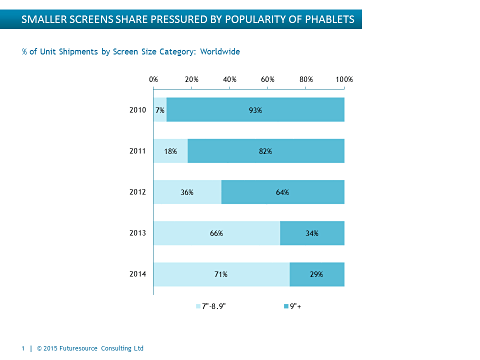According to the latest Worldwide Tablet Report from Futuresource Consulting the emergence of low-cost Android devices are causing a dilution of Apple’s market share. The introduction of lower-priced iPads, and the aggressive PC brand pricing strategy has made the average tablet price fall dramatically between 2010 and 2014.
In spite of continued growth in shipment volume throughout the forecast period within the report, Futuresource anticipates the slowing of retail value growth in the worldwide
tablet market as consumer sales plateau and retail prices continue a steady decline from 2014. While some emerging markets enjoyed unit growth in excess of 30% in 2014, several major markets saw low or even negative growth.

B2B sales will become an increasingly significant driver of future demand, particularly in developed markets. For emerging markets, any pent up business to business (B2B) demand will still be constrained by price.
“Workplace tablet use has been driven principally by bring your own device “BYOD” and tablets are used in a more complementary role rather than as a replacement for the PC,” commented Simon Bryant, Associate Director Consumer Electronics at Futuresource Consulting. Bryant continued saying that “Issues of security and untested apps on tablets have also previously suppressed B2B demand, although many of these fears have been allayed with many tablets now carrying the same security policies and enforcement as a laptop.”
Futuresource highlights that that the drive behind B2B sales will be the availability of productivity apps, unifying software platforms, improved battery life and technology comparable to today’s PCs; by 2019 B2B is expected to make up 30% of total shipments. The development of the B2B sector could be boosted further by the introduction of larger screened, fully-featured tablets, specifically those from Apple and the PC vendors.
Smaller screen tablets currently command significant market share, taking 71% of shipments in 2014. This category however is most at risk by the rise in demand for phablets, as sales of large screen smartphones collide with those of smaller-screen Tablets. As a consequence, larger screened tablets are expected to increase future share with manufacturers also shifting production from 7 to 8+ inch devices by end 2015.
This latest report goes much deeper into the developments in the tablet market in terms of volume, retail and trade value and key vendors, forecasts based on underlying market drivers and future trends. This detail is presented individually for 26 countries and 11 regions. Shipment data is presented at sell-in level (manufacturers’ sales to retail). Installed base and ownership levels are assessed, based on retail sales and knowledge of replacement rates.


